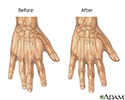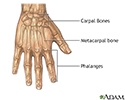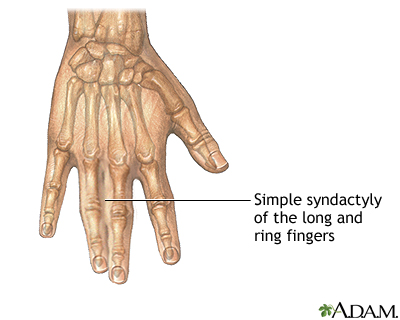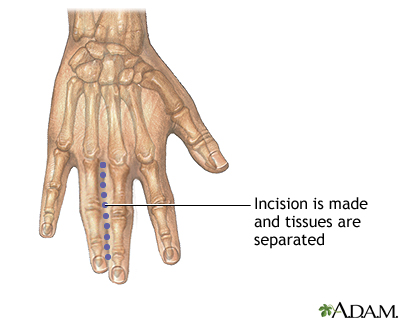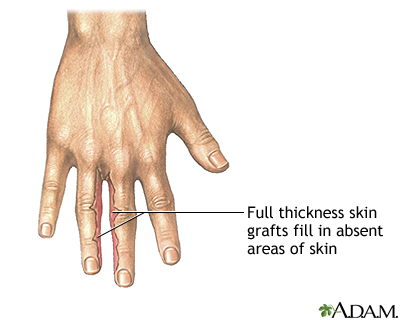Repair of webbed fingers or toes
Web finger repair; Web toe repair; Syndactyly repair; Syndactyly release
Repair of webbed fingers or toes is surgery to fix webbing of the toes, fingers, or both. The middle and ring fingers or the second and third toes are most often affected.
Webbed fingers or toes
Webbing of the fingers or toes is called syndactyly. It refers to the connection of 2 or more fingers or toes. Most of the time, the areas are conn...
Description
Surgery is done the following way:
-
General anesthesia
will be given. This means the person is asleep and unable to feel pain. Or regional anesthesia (
spinal and epidural
) is given to numb the arm and hand.
General anesthesia
General anesthesia is treatment with certain medicines that puts you into a deep sleep so you do not feel pain during surgery. After you receive the...
Read Article Now Book Mark ArticleSpinal and epidural
Spinal and epidural anesthesia are medicines that numb parts of your body to block pain. They are given through shots in or around the spine....
Read Article Now Book Mark Article - The surgeon marks the areas of the skin that need repair.
- The skin is cut into flaps, and the soft tissues are cut to separate the fingers or toes.
-
The flaps are sewn into position. If needed, skin taken (
graft
) from other areas of the body is used to cover places that are missing skin.
Graft
A skin graft is a patch of skin that is removed by surgery from one area of the body and transplanted, or attached, to another area.
 ImageRead Article Now Book Mark Article
ImageRead Article Now Book Mark Article - The hand or foot is then wrapped with a bulky bandage or cast so that it can’t move. This allows healing to take place.
Simple webbing of fingers or toes involves only the skin and other soft tissues. The surgery is more complicated when it involves fused bones, nerves, blood vessels, and tendons.
Why the Procedure Is Performed
This surgery is advised if the webbing causes problems with appearance, or in using the fingers or toes. Generally, the repairs are done when a child is between 6 months and 2 years old.
Risks
Risks for anesthesia and surgery in general include:
- Problems breathing
- Reactions to medicines
- Bleeding, blood clot, or infection
Other possible complications related to this surgery include the following:
- Damage from not getting enough blood in the hand or foot, due to the cast
- Loss of skin grafts
- Stiffness of the fingers or toes
- Injuries to the blood vessels, tendons, or bones in the fingers
Call your provider if you notice the following:
- Fever
- Fingers that tingle, are numb, or have a bluish tinge
- Severe pain
- Swelling
After the Procedure
Most people stay in the hospital for 1 to 2 days.
Sometimes the cast extends beyond the fingers or toes to protect the repaired area from injury. Small children who had webbed finger repair may need a cast that reaches above the elbow.
Outlook (Prognosis)
The repair is usually successful. When joined fingers share a single fingernail, the creation of two normal-looking nails is rarely possible. One nail will look more normal than the other. Some children require a second surgery if the webbing is complicated.
The separated fingers will never look or function the same.
References
Kay SP, McCombe DB, Kozin SH. Deformities of the hand and fingers. In: Wolfe SW, Hotchkiss RN, Pederson WC, Kozin SH, Cohen MS, eds. Green's Operative Hand Surgery . 7th ed. Philadelphia, PA: Elsevier; 2017:chap 36.
Mauck BM, Jobe MT. Congenital anomalies of the hand. In: Azar FM, Beaty JH, Canale ST, eds. Campbell's Operative Orthopaedics . 13th ed. Philadelphia, PA: Elsevier; 2017:chap 79.
-
Before and after webbed finger repair - illustration
The results of webbed finger repair are dependent on the degree of fusion of the fingers. When joined fingers share a single fingernail, the creation of two nails that each look normal is rarely possible. One nail will look more normal than the other. Some children require a second surgery, depending on the complexity of the syndactyly.
Before and after webbed finger repair
illustration
-
Syndactyly - illustration
Fingers or toes (digits) may be fused together (syndactyly) or the webbing between them (inter-digital webbing) may extend far up the digits. Syndactyly is seen commonly between the second and third toes, and may sometimes be associated with a syndrome.
Syndactyly
illustration
-
Repair of webbed fingers - series
Presentation
-
Before and after webbed finger repair - illustration
The results of webbed finger repair are dependent on the degree of fusion of the fingers. When joined fingers share a single fingernail, the creation of two nails that each look normal is rarely possible. One nail will look more normal than the other. Some children require a second surgery, depending on the complexity of the syndactyly.
Before and after webbed finger repair
illustration
-
Syndactyly - illustration
Fingers or toes (digits) may be fused together (syndactyly) or the webbing between them (inter-digital webbing) may extend far up the digits. Syndactyly is seen commonly between the second and third toes, and may sometimes be associated with a syndrome.
Syndactyly
illustration
-
Repair of webbed fingers - series
Presentation
Review Date: 9/22/2016
Reviewed By: C. Benjamin Ma, MD, Professor, Chief, Sports Medicine and Shoulder Service, UCSF Department of Orthopaedic Surgery, San Francisco, CA. Also reviewed by David Zieve, MD, MHA, Isla Ogilvie, PhD, and the A.D.A.M. Editorial team.

